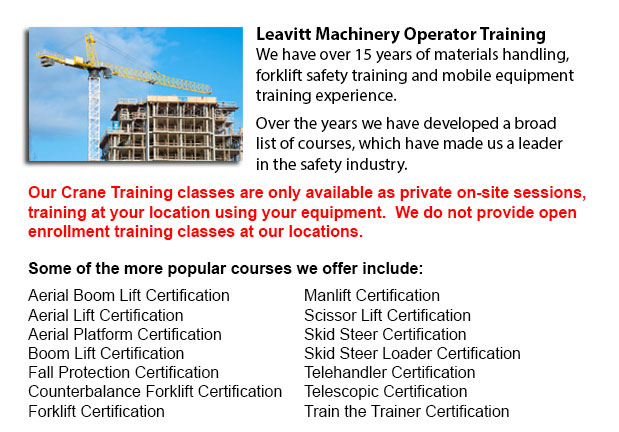
Overhead Crane Operator Training Regina - The program teaching overhead crane operator training has been meant specially to instruct trainees on the basics of pre-shift checks and overhead crane/sling operation. The programs are instructed by professional trainers and consultants. Well-trained workers are more productive and efficient, which really saves on expenses associated with property damage, merchandise damage, and accidents due to the use of incorrect operating measures. Our overhead crane certification is customized for staff who have literacy barriers, reducing certification time by 50 per cent.
Overhead cranes are suitable for particular repetitive hoisting activities. This type of crane has wide ranging capacities. They could be used for specialized hoisting tasks such as installing or removing major plant machines.
To safely use an overhead crane, staff must employ safe rigging practices. This requires both knowledge and practice. The load should be rigged correctly to ensure its stability when hoisted. Prior to beginning a lifting task, it must be determined that the crane is suitable for the task, with right capacity, travel and lift. The crane must be subjected to a thorough visual and physical inspection before utilization. The capacity of all machinery, including the rope, slings and hardware, must never go over load weight capacities.
The rigger must know the right sling for each and every lift and check slings and other rigging hardware before using. Clear signals must be used in communications with the crane operator. A signaler should be designated for the role and signals must be agreed upon. The operator of the crane should follow instructions from the chosen person only. If a remote or wired controller is being used, the operator should be trained in all its functions.
To guarantee the safety of staff, a warning should be issued and the path of the load must be cleared of all obstructions before the lift begins. People must not be allowed to walk beneath the lift loads. The crane hoist must be centered over the load prior to lifting in order to prevent swinging. The safety catch should be closed immediately after sliding the sling fully onto the hoisting hook. Unused sling legs should be secured so they do not drag. Never leave loose materials on a load being lifted. Watch that hands and fingers are clear when slack is taken out of a sling. Step clear of the danger zone before the lift is carried out.
-
Forklift Training Classes Regina
Forklift Training Classes Regina - Forklifts are a kind of heavy lifting equipment used in order to move and handle material efficiently and safely. Sometimes called Lift Trucks, they are made use of in different industries. Employees working with an... More -
Crane Certification Regina
Crane Certification Regina - The Crane Certification Program covers the industry suggested content which would teach the safe and efficient operation of cranes. The person will train in the following: pre-operational, operational and post operating r... More -
Telehandler Training Courses Regina
Telehandler Training Courses Regina - Employers are responsible for making sure that their operating personnel and supervisors are trained to work proficiently utilizing telehandler machines. The competence level of employees need to be assessed. If... More -
Operator Safety Training, Re-Qualification Training, In-House Instructor Training in Regina
Lift trucks are utilized in just about all industrial construction sites and in warehouse operations and in boat yards. The reach feature of a lift truck is a very important component utilized in a variety of applications like for instance when a she... More -
Heavy Equipment Operator Training Regina
Heavy Equipment Operator Training Regina - Training facilities that offer good standards in the business and not only provide field performing tasks but additional equipment training are highly sought after. Accredited schools offer students the know... More -
Wheel Loader Operator Training Regina
Wheel Loader Operator Training Regina - Cranes are industrial machines which make use of pulleys or levers so as to lift considerable loads. The Roman people utilized cranes in order to put up big monuments, that means these machines have been existi... More -
Crane Safety Training Regina
Crane Safety Training Regina - Both crane driver as well as their supervisors need to know all the possible problems connected to the operation of an overhead crane. All over North America, there is legislation that provides regulation for the safe o... More -
Scissor Lift Safety Training Regina
Scissor Lift Safety Training Regina - A Scissor Lift is a functional kind of platform that normally moves in a vertical direction. The machinery is capable of this movement due to the use of folding supports that are linked in a criss-cross pattern c... More

Forklift Training Regina
TOLL FREE: 1-888-254-6157
Regina, Saskatchewan
forklifttrainingregina.com
Email Us
About Us



